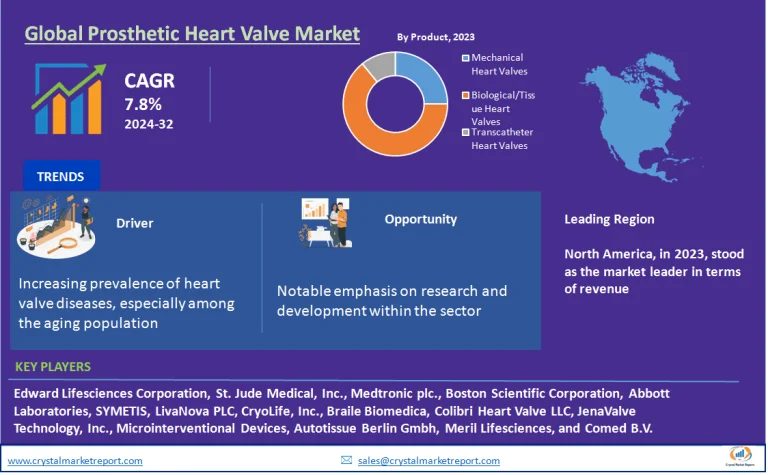Market Overview
The prosthetic heart valve market pertains to the segment of the medical devices industry responsible for replacing damaged or malfunctioning heart valves. These artificial valves are paramount for restoring normal blood flow, ensuring optimal heart functionality, and improving the patient's quality of life. The prosthetic heart valve market is estimated to grow at a CAGR of 7.8% from 2024 to 2032.
Prosthetic Heart Valve Market Dynamics
Driver: Increasing prevalence of heart valve diseases, especially among the aging population
For instance, according to the World Health Organization, cardiovascular diseases (CVDs) remain the number one cause of death worldwide, taking an estimated 17.9 million lives each year. Out of these, a significant portion can be attributed to heart valve disorders. Furthermore, the increasing sedentary lifestyle, rife with factors such as poor dietary habits, lack of physical activity, and excessive smoking and drinking, further contribute to the escalating number of patients requiring valve replacement. Technological advancements have also played a role. The emergence of transcatheter heart valves, which offer a less invasive alternative to open-heart surgery, has especially appealed to older patients, who might not be ideal candidates for traditional surgery due to associated risks.
Opportunity: Notable emphasis on research and development within the sector
Medical device companies have been keen on developing prosthetic heart valves with enhanced lifespan, reduced complications, and improved patient outcomes. One such evidence is the increasing number of FDA approvals for next-gen prosthetic valves. These new valves, made of durable materials and designed for optimal hemodynamics, promise a better post-operative life for patients. Moreover, emerging markets in regions such as Asia-Pacific and Latin America are yet to be fully tapped, offering a vast potential customer base, spurred by rising income levels and increasing awareness of advanced healthcare treatments.

Restraints: High cost of heart valve replacement surgeries
The high cost of heart valve replacement surgeries, especially transcatheter procedures, has been prohibitive for many. While in developed nations, insurance might cover these, in developing regions, the steep price often becomes a deterrent for a significant portion of the population. Furthermore, the risks associated with prosthetic heart valve implantation, including device malfunction, blood clots, and endocarditis, can sometimes overshadow the benefits, making patients hesitant.
Challenge: Stringent regulatory hurdles
Before reaching the market, these valves undergo rigorous testing and scrutiny to ensure they meet the safety and efficacy standards set by regulatory bodies. The clinical trials are not only time-consuming but also capital-intensive. Evidence of this can be seen in the occasional recalls issued for certain models of prosthetic heart valves when post-market surveillance identifies potential risks, which further underscores the rigorous regulatory environment and the challenges manufacturers face.
Market Segmentation by Product
In 2023, Biological/Tissue Heart Valves registered the highest revenue. Their popularity stemmed from their ability to offer a more natural valve replacement without the need for lifelong anticoagulant medication, a necessity for mechanical valves. On the flip side, Transcatheter Heart Valves, a newer entrant, witnessed the highest CAGR. Their minimally invasive implantation, especially beneficial for patients deemed high-risk for open-heart surgery, catapulted their demand. Mechanical Heart Valves, while reliable, have seen a comparatively subdued growth due to the requirement for life-long medication and certain lifestyle adjustments.
Market Segmentation by End User
When segmented by End User, Hospitals and Ambulatory Services come into focus. In 2023, hospitals held the highest revenue share in the prosthetic heart valve market. This dominance can be attributed to the intricate nature of heart valve replacement surgeries, which often necessitates advanced infrastructural capabilities, only available in hospital settings. However, with the rise of Transcatheter Heart Valves and the push towards outpatient care, Ambulatory Services are expected to register a higher CAGR from 2024 to 2032. The shift towards these services is driven by cost-saving measures and the convenience of minimally invasive procedures.
Market Segmentation by Region
North America, in 2023, stood as the market leader in terms of revenue. Factors such as advanced healthcare infrastructure, high patient awareness, and a notable prevalence of cardiovascular diseases bolstered this dominance. However, the Asia-Pacific region is forecasted to exhibit the highest CAGR from 2024 to 2032. Factors fueling this growth include improving healthcare infrastructure, rising disposable incomes, burgeoning patient awareness, and the sheer population numbers that translate into a massive patient pool.
Competitive Trends
Some top players that have been steering the market's direction include Edward Lifesciences Corporation, St. Jude Medical, Inc., Medtronic plc., Boston Scientific Corporation, Abbott Laboratories, SYMETIS, LivaNova PLC, CryoLife, Inc., Braile Biomedica, Colibri Heart Valve LLC, JenaValve Technology, Inc., Microinterventional Devices, Autotissue Berlin Gmbh, Meril Lifesciences, and Comed B.V. In 2023, these companies prioritized innovative product launches, strategic acquisitions, and expansive distribution networks to gain a competitive edge. Their R&D endeavors often revolved around enhancing valve durability, reducing complications, and ensuring easier implantation procedures. As we move into the period from 2024 to 2032, it's anticipated that partnerships with tech firms to incorporate AI and machine learning for better diagnostics and post-operative monitoring will become a key strategy. Furthermore, market penetration in untapped regions, especially in developing countries, is expected to be a major focus, leveraging localized strategies and cost-effective products tailored for those markets.